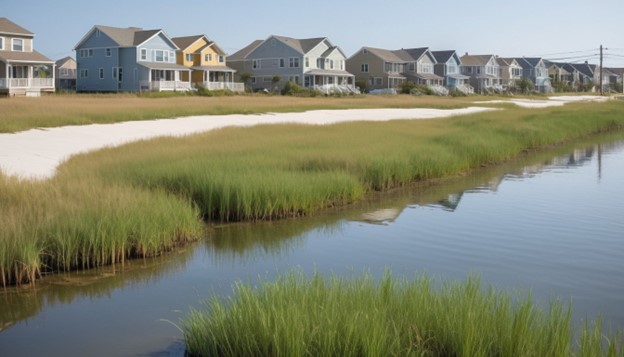Clarifying the Virginia Tidal Wetlands Act: Creating Criteria to Propel Implementation of Living Shorelines
By Charlotte Bieri | Staff Editor
March 18, 2024
—
Consider the scenario of a property owner, facing a mosquito infestation on their land, who decides to drain stagnant water by diverting it onto a neighboring property. This seemingly practical solution for one landowner, eager to address their immediate concern, creates a mosquito-free haven for themselves but inundates their neighbor with unwanted water and potential flooding issues.
The Virginia Marine Resources Commission (VMRC) acknowledged 27 years ago that hardened shorelines while addressing immediate erosion issues, harm water quality, exacerbate flooding, and diminish commercial marine stocks.[1] Like the above scenario, although the hardened structures are immediate solutions for shoreline erosion on waterfront property, they cause more harm in the long run.
Since then, the Virginia Assembly has been strengthening the language in the Virginia Tidal Wetlands Act (VTWA) to increase the implementation of living shorelines. Living shorelines are a shoreline stabilization method that involves the strategic placement of natural materials to “enhance coastal resilience and attenuation of wave energy and storm surge.”[2] The VTWA is the first statutory language linked living shorelines to coastal resilience goals.[3]
Beyond their ecological benefits, living shorelines play a pivotal role in water quality by filtering nutrients and pollutants.[4] Acting as effective absorbers of storm surges and floodwaters, they provide a natural defense mechanism against extreme weather events.[5] Additionally, living shorelines act as carbon sinks, mitigating climate change by sequestering carbon in coastal ecosystems.[6] Beyond environmental benefits, living shorelines have broader social and economic impacts, supporting diverse fish and wildlife populations, enhancing property values, and fostering community enjoyment through recreational activities.[7] As holistic alternatives to conventional stabilization methods, living shorelines are a sustainable and community-enriching approach to coastal management.
The VTWA was created in 1972 to preserve wetlands while accommodating economic development.[8] In 2011, the VTWA established living shorelines as the “preferred” shoreline stabilization method in hopes of incentivizing property owners to choose them when determining their stabilization strategy.[9] However, a study from 2016 identified that 74% of permitted projects on unaltered shorelines failed to embrace living shorelines.[10] To increase the implementation of green shoreline stabilization methods, VTWA required stronger language to effectively change landowner’s behavior. The statute was amended in 2022, requiring the Commission to “permit only living shoreline approaches to shoreline management unless the best available science shows that such approaches are not suitable.”[11] The statute even requires the integration of non-structural elements into hard-structuring projects.[12] Another shoreline resilience win for Virginia!
However, the “best available science” standard is subjective.[13] The lack of clear criteria within the statute defining “best available science” could lead to inconsistent application of the law. The burden of proof for what type of stabilization structure is most suitable due to the “best available science” belongs to the waterfront property owner, who, most of the time, does not know the difference between sustainable shoreline stabilization mechanisms and traditional hard armoring practices.[14] Frequently, property owners implement shoreline stabilization strategies uniform to their neighbors—causing a ripple effect of a quick-fix stabilization method that does more harm to the shoreline and water system in the long run.[15] The burden of proof being on the property owner could lead to VMRC and Local Wetlands Boards having waterfront property owners demanding a permit for a hardened shoreline, even if it is not the best approach. [16]
Maryland’s shoreline stabilization statute includes a list of factors a property owner must consider to waive the requirement to implement living shorelines.[17] Some of these factors include the width of the waterway, the bottom substrate, the regularity of tides, and the degree of erosion.[18] Virginia’s statute, alongside the “best available science” standard[19], should include criteria similar to Maryland’s for property owners to consider when determining the most suitable shoreline stabilization method. The incorporation of clear criteria would make the permit process more straightforward for property owners and limit diverse interpretations among stakeholders and regulatory bodies—resulting in increased implementation of sustainable shoreline stabilization methods.
—
[1] Jim Lang, SB776 Requires Proof for Hardened Shoreline Installation, Jim Lang Waterfront Law, (Nov. 6, 2020), https://www.waterfrontpropertylaw.com/blog/posts/sb776-requires-proof-for-hardened-shorelines/.
[2] VA. Code Ann. § 28.2-104.1(C)(1) (2022).
[3] Shana Jones, Note, Stabilizing the Edge: Southeastern and Mid-Atlantic Shorescapes Facing Sea Level Rise, 46 Colum. J. Envtl. L. 293, 353 (2021).
[4] Advantages and Disadvantages of Soft Shoreline Stabilization, InTeGrate (Oct. 19, 2023), https://serc.carleton.edu/integrate/teaching_materials/coastlines/student_materials/1073.
[5] Id.
[6] Id.
[7] Nat’l Oceanic & Atmospheric Admin., Natural and Structural Measures for Shoreline Stabilization 1, 7 (2015), https://coast.noaa.gov/data/digitalcoast/pdf/living-shoreline.pdf.
[8] § 28.2-1300-1315 (1972).
[9] See § 28.2-104.1(C)(1) (2022).
[10] Marcia Berman et al., Implementing Sustainable Shoreline Management in Virginia: Assessing the Need for an Enforceable Policy, 3 (2018).
[11] § 28.2-104.1(D) (2022).
[12] See Id.
[13] Id.
[14] § 2.2-4020 (2016)(“The burden of proof shall be upon the proponent or applicant.”).
[15] Jim Lang, supra note 1.; Christopher Antoine, Increasing Living Shoreline Implementation in Virginia: Legal and Policy Recommendations, 41 (2018).
[16] Jim Lang, supra note 1.
[17] MD. CODE. REGS. 26.24.04.01 (E)(2) (2022).
[18] See § 26.24.04.01-2(B)(1)-(9) (2021).
[19] VA. Code Ann. § 28.2-104.1(D) (2022).

